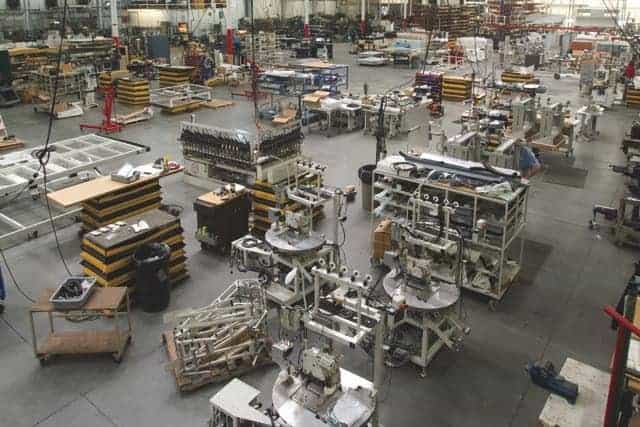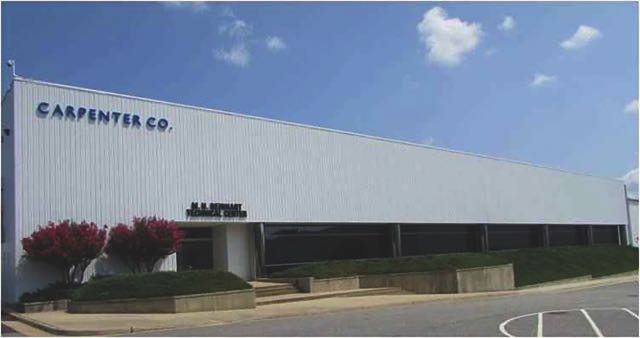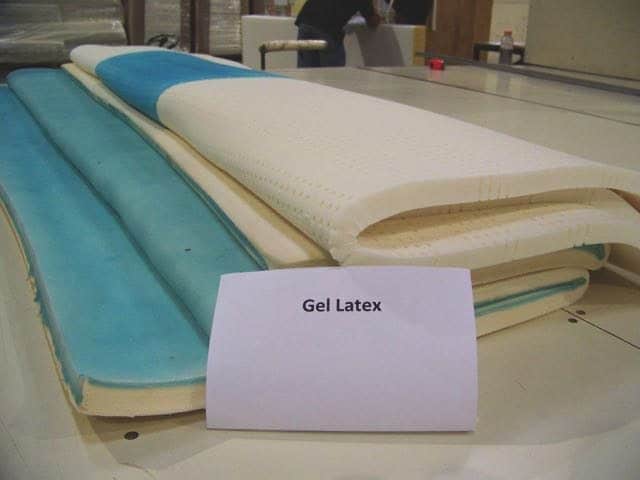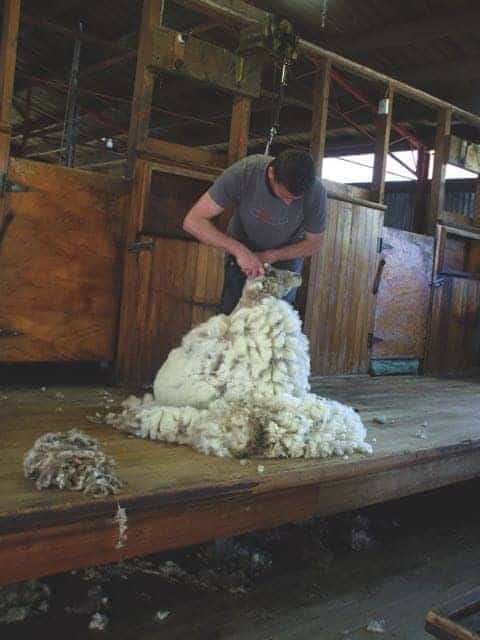With increased demand for innovation, collaboration among manufacturers and suppliers becomes more important than ever
As the mattress industry experiments with technologies, styles and features to satisfy today’s consumer, collaboration between suppliers and manufacturers grows increasingly important to the development of new and better products.
A decade ago, cost was a principal driver in the sleep-products segment, industry executives say. Today, the consumer sits behind the steering wheel, and innovation fuels a rapidly evolving marketplace. Suppliers across the industry—be they large, medium or small—are responding to their customers by developing new materials, services and equipment that can be used to create the sophisticated products that consumers are demanding.

Leggett & Platt engineers Erin Wampler (left) and Kyle Tucker make adjustments to a quilting machine at the company’s testing facility in Carthage, Missouri.
“Ten years ago, the predominant drive in bedding was to take cost out of the mattress,” says Eric Rhea, president of Carthage, Missouri-based supplier Leggett & Platt’s Bedding Group. “Today, more than ever before, we are in-tune with consumers and retail sales associates. That connection has led to more development around consumer value—specifically comfort and convenience—and around significant benefits to the bedding manufacturer. Those are the big changes. The focus is on adding value to the consumer and to manufacturers.”
Tim McRee, vice president of Baltimore-based William T. Burnett & Co., a supplier of foam and fiber products, agrees.
“Components used by most mid- and high-end bedding manufacturers have gone from being commodity products to being more specialized technical products,” he says. “Now we are seeing manufacturers putting quality and lasting components in a bed that are going to add value to the sleep surface for the customer, the consumer.”
For McRee, the trend toward adding value means a sharp increase in demand for natural fibers such as wool, cotton and horsehair. These fibers are being used in meaningful amounts—percentages ranging from 80% to 100%, he says, and each of these components adds something of value to the bed.
William T. Burnett works with research-and-development groups from the bedding majors and high-end independent manufacturers to create products that help them stand apart in the industry. This differentiates them from their competitors and puts them “on the cutting edge.”
“They don’t want to be a ‘me too’ company. They want to be the leader,” McRee says. “You have to give the consumer a reason to spend the extra money for a high-priced bed, and these products bear a lot of perceived and actual value for the retail customers.”
For example, McRee says, he’s now working to put pads primarily made of horsehair and wool, both felted and densified, in the upholstery layer of a mattress. “We are going back to the way beds were made 100 years ago with these natural materials,” he says. “We are seeing those placed inside the interior of the bed, and they are all renewable products. … And the consumer is demanding these types of components in the high-priced beds.”
The call of consulting

A supplier of sewing products, Chicago-based A. Lava & Son Co. is brought in early during production to help select “color tones and messaging points that my customers want to send with these beds,” says co-owner Adam Lava.
Today’s suppliers function more as consultants to their customers, partnering with manufacturers early in the R&D process, says Adam Lava, co-owner and vice president of Chicago-based A. Lava & Son Co., a diversified supplier of sewing and textile products.
“Our company has changed quite a bit from a pure commodity business to actually being part of the design arms of our customers’ companies to create the look of a bed that portrays the message they are trying to get through, both from a marketing standpoint and a product-specific standpoint,” he says.
Fashion is playing a larger role in the retail experience, Lava says, and manufacturers are more inclined to seek outside assistance. “They are using their vendors’ expertise to help them produce their consumer products, as opposed to them doing 100% themselves. I think it is a change in culture. With the younger generation it is much more of a collaborative effort. It is a generational shift.”
Typically, mattress manufacturers bring in Lava at the beginning of the production phase as opposed to the end.
“From the very beginning, we are picking color tones and messaging points that my customers want to send with these beds,” he says. “As opposed to them putting up a wall and picking out the paint and we just paint it, we are helping them decide where the wall goes, what color paint to use and the brush stroke technique. It’s more than just painting; it’s the artistry of how to paint that wall.”
Becoming increasingly important for Lava’s customers are designs that dazzle on electronic screens and not just in print materials (think newspaper ads).
“To get the look you want, you need to pick colors and tones that pop out on cellphone screens or computer monitors. Those are the media that people use to see it. Then they go into the store,” he says. “I think the industry has realized that photography and the imaging of the bed are crucial.”
Although customers want their beds to stand out on the retail floor, Lava says it’s important not to stray too far out of the “design box.”
“They don’t want to risk offending consumers with their design, but they want to be forward-thinking. From A. Lava’s point of view, we try to go right up to that line without crossing it,” he says. “And the line always is moving, so it’s a challenge for our designers on a daily basis.”
While Leggett & Platt develops many of its own products for introduction to the entire market, it also works closely with customers to co-develop products. To inform that process, the company conducts a significant amount of research—quantitative and qualitative—at both the RSA and the consumer levels, Rhea says.
“More than ever, our customers view us as consultants who help them identify what is specifically going on in the worldwide bedding market and pinpoint trends developing in the domestic market,” he says. “We also have an extensive testing facility in Carthage where we offer customers a variety of development services.”
That facility operates as “a central nervous system” that links all of Leggett’s product development. “There continues to be more and more demand for new product innovation,” Rhea says. “That is a growing requirement with any business unit, to continue helping your customers drive more value to the consumer and differentiate their products.”
Hank Little, president of machinery supplier Atlanta Attachment Co. Inc., based in Lawrenceville, Georgia, notes that R&D has evolved considerably at his company; it functions today as a customer service along with new product development.

Research and development at machinery supplier Atlanta Attachment Co. Inc., based in Lawrenceville, Georgia, includes a significant customer-service aspect.
“As products and the industry have changed, with each manufacturer working on unique products, development assistance in constructing products and aesthetics have become key areas we are involved in,” Little says.
Atlanta Attachment offers a full range of R&D services, from concept to design, including prototyping and testing, project and plant rollout, and design innovations. Customers today are looking for customization with “machine intelligence” that provides market flexibility, increased productivity and new technology, he says.
“Fortunately, we have a full working showroom and almost every week we have visits from customers with whom we work very closely,” Little adds.
Innovation is key
Innovation is the emphasis at Carpenter Co.’s state-of-the art Reinhart Technical Center in Richmond, Virginia, says Bob Steelman, vice president of sales and marketing for the company’s bedding division. The components supplier provides comfort-cushioning products to the mattress industry.

Components supplier Carpenter Co.
emphasizes innovation at its state-of-the art Reinhart Technical Center in Richmond, Virginia, where the company creates
cushioning products for the mattress industry.
“We’ve hired scientists to do that not only short-term, but to look five to 10 years down the road, so you constantly have someone working on innovative ideas and products,” Steelman says.
“With someone like Tempur Sealy International, for instance, we have cross-functional teams, and one emphasis is on customer input and collaboration,” he adds. “We’ll get our R&D side with their R&D side, and go even further by bringing in sales and marketing folks. It is especially important to know what they think is going to sell at retail. Collaboration has become a key, including the technical sides and sales and manufacturing—a cross-functional team is the most effective way to get where you need to go.”
The earlier in the product-development process the collaboration begins, the better.
In 2012, HSM Solutions opened its Corporate Innovation and Technology Center in Conover, North Carolina, near its headquarters in Hickory for testing products in furniture, bedding, transportation and other diversified markets.

Pressure mapping at HSM Solutions’
Corporate Innovation and Technology
Center in Conover, North Carolina,
enables the company to gain insights into the comfort differences
of various bedding products.
The center also provides a setting for HSM’s customers and vendors to work collaboratively on new products, programs and services. HSM encourages the original equipment manufacturers it partners with to take advantage of the center’s testing capabilities at an early stage, says Gregg Greulich, corporate vice president of innovation and technology.
“We’ve evolved our testing into an integrated solutions process,” Greulich says. “Ideally, we work together starting at the front end of new-product development all the way through to launch.”
More and more, HSM and its OEM partners are using the center to assist with product development. “Testing has always been a critical element for HSM to ensure compliance with regulatory and safety requirements,” Greulich says. “Now, we’re also using these capabilities to investigate new technologies and innovations that enhance our products’ ability to deliver quality sleep.”
By working more closely with OEMs at an early stage of product development, says Bobby Bush, senior vice president of foam technology for HSM, the company has improved its ability “to figure out how our foams and springs can most effectively work together to create a total package. Their input enables us to fine-tune our products to make them the best they can be.”

Latexco, with headquarters in Tielt, Belgium, operates a plant in Georgia with a 200-foot continuous production line that enables the company to create gel latex toppers like these.
Latexco, headquartered in Tielt, Belgium, operates a plant in Georgia that works closely to innovate with Atlanta-based Simmons Bedding Co., says Roger Coffey, president of Latexco West LLC. Just 90 miles apart, the companies work together on a weekly, sometimes even daily, basis.
The plant’s 200-foot continuous production line enables Latexco to create such products as Puralux Gel, a solid thermoplastic polymeric gel application that is part of the Puralux Memory line, which includes standard latex and a hybrid visco-elastic latex. This gel product’s coverage can be adjusted by Latexco to levels ranging from 25% to 100%, offering bedding producers the ability to hit a range of price points and create exclusive applications.
“We recognize we’ve been a latex company since the startup in 1975, but the line in Georgia can combine plush comfort along with solid support features like no other producer,” Coffey says. “Complementing this line we have now introduced a specialized polyurethane process that deals with the comfort features so needed in beds produced today, thus making us a ‘comfort supplier’ to the industry, not just a latex supplier.”
Everyone can be a player
Tom Taylor, the owner of nonwovens supplier Taylor & Associates, proves that supply-chain collaboration is not only a need in today’s marketplace but a realistic possibility, whether you’re a giant or a solo practitioner. He partnered with German polyester manufacturer Advansa Co. to create ThermoCool, a product incorporated into ticking fabric that helps regulate temperature.
“I took it to a lot of people before I got to Serta, and they saw it as a fit for their iComfort beds,” Taylor says. “The fiber both acts when there is moisture present—it evaporates it at a very quick rate for a cooling effect—and, simultaneously, there is another fiber that acts as an insulator that traps air and maintains temperature.”
Although ThermoCool is no longer in Taylor’s portfolio of products, he is “working on very similar things for mattress toppers and mattress pads now,” he says.
Taylor and other suppliers say the connection between a good night’s sleep and good health is front and center for today’s consumers.
Health-wellness connection
“It’s about the importance of a good night’s sleep, rather than a different mattress or a different ticking,” Steelman says. “It has evolved into a health and wellness theme. There is a call for products that solve problems or perceived negatives.”
The trend toward sleep products that promote good health led Carpenter to partner with Tempur Sealy and Boulder, Colorado-based Outlast Technologies Inc. to create and topically apply phase-change material that absorbs energy when the environment or body temperature goes up, storing this energy temporarily for a cooling effect and then releasing it as heat when temperature cools down.
“It is a scientific solution to that problem. And we have invested in Active Air technology, where we physically put holes in the top surface of a mattress so it can breathe. Especially with the advent of all-foam mattresses, air flow is critical,” Steelman says.
The “green movement” opened a new market for Latexco, Coffey says. “People started to say we don’t want synthetic, we don’t want blends. Then we began to work on other products based on their feedback to us. The green movement has grown tremendously in the last 10 to 15 years. There became a marketplace that wasn’t there before.”
Indeed, Taylor notes his market for natural products has grown by double digits in recent years. He says he looks at the attributes of available products and then figures out a way to incorporate those products into a sleep system—be it a mattress, a topper or a pillow—that provides functional value to the consumer.
For example, Taylor teamed up with McRee to produce a 100% wool pad, which Taylor says “absorbs 30% of its weight in moisture and still breaths, providing a measurable comfort change.”

At Baltimore-based William T. Burnett & Co., the demand for natural fibers such as wool has increased sharply because consumers want the added value.
“They are mechanically bonded, rather than using plastics or resins,” he says. “Most of the wools we had been selling were blended. The mattress buyer has shown a strong preference for a 100% Joma wool comfort layer over a blended product.”
Taylor says he frequently fields calls from manufacturers asking about Joma wool, his premier product from Christchurch, New Zealand-based John Marshall & Co. Ltd. Once he determines how they plan to use it, he partners with McRee to customize a product for the application. “Right now we have a new cotton-wool blend, all-natural fiber. There is a segment of the market that wants all natural.”
The sleep-products industry continues to change, Taylor says, particularly with consolidation of mattress makers and the changing demographics of consumers.
And there remains a long path to travel to market, Taylor notes. He’s spent several years working with Advansa to create a “carbon-neutral” pillow that has yet to go to market. The company substantially has reduced the carbon emissions that occur when it manufactures the fiber, Taylor says, and has offset the remaining carbon emissions by financing wind power and other projects whose goals are to reduce overall carbon emissions by an equivalent amount.
“Retailers have to make a decision to put it on the shelf … only then will we know if the person going into the store actually will buy it,” he says. “You never know until you put it before the consumer.”




